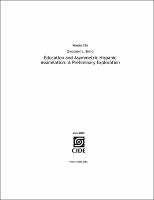| dc.creator | Brito, Dagobert L. |
| dc.date.issued | 2005 |
| dc.identifier | 060921.pdf |
| dc.identifier.uri | http://hdl.handle.net/11651/6134 |
| dc.description.abstract | In a recent book, Samuel Huntington argues that Hispanic immigration threatens “America’s identity, values and way of life.” He supports this argument by citing data that supports the widely held belief that Hispanics have not assimilated as well as other ethnic groups, and in fact some investigators have reported that the educational achievement of Hispanics actually declines in the third and fourth generations. This paper uses the data from the National Longitudinal Survey of Youth 1997 (NLSY97) to explore the implications of the assumption that Hispanics who are high school graduates are more likely to intermarry with the rest of the non-Hispanic population than Hispanics who are not high school graduates. The calculations in this paper suggest that the perception that Hispanics are not assimilating as well as other immigrant groups can be explained by selective assimilation that removes a large fraction of the more educated members of the group from the population that is being observed. Thus, the observations about third and subsequent generations of Hispanic immigrants should be questioned. The NLSY97 data and calculations based on that data suggest that the reason for the perceived lag in Hispanic assimilation is the high rate of intermarriage among that portion of that population with high human capital. |
| dc.description.abstract | En un libro reciente, Samuel Hutington argumenta que la inmigración hispana amenaza “la identidad, los valores y el modo de vida de América”. Él apoya sus argumentos citando datos que sustentan la creencia ampliamente aceptada de que los “Hispanos” no se han asimilado tan bien como otros grupos étnicos. De hecho, algunos investigadores han reportado que los logros educacionales de los Hispanos han declinado en la tercera o cuarta generación. Este artículo usa datos de la Encuesta Longitudinal Nacional de la Juventud de 1997 (NLSY97) para explorar las implicaciones del supuesto de que los Hispanos que son graduados de “High School” son mas susceptibles de casarse con el resto de la población no-Hispana que los Hispanos que no se gradúan del High School. Los cálculos en este artículo sugieren que la percepción de que los Hispanos no se asimilan tan bien como otros grupos puede ser explicada por asimilación selectiva que remueve a la gran fracción de los miembros mas educados del grupo de la población que es observada. Por tanto, las observaciones de la tercera y las subsecuentes generaciones de inmigrantes hispanos deben ser cuestionadas. Los datos de la NLSY97, y los cálculos basados en tales datos, sugieren que la razón para el rezago percibido en la asimilación hispana es la alta tasa de matrimonios entra la porción de población con alto capital humano. |
| dc.format | application/PDF |
| dc.language.iso | eng |
| dc.publisher | Centro de Investigación y Docencia Económicas, División de Economía |
| dc.relation.ispartofseries | Documento de trabajo (Centro de Investigación y Docencia Económicas). División de Economía; 316 |
| dc.rights | El Centro de Investigación y Docencia Económicas A.C. CIDE autoriza a poner en acceso abierto de conformidad con las licencias CREATIVE COMMONS, aprobadas por el Consejo Académico Administrativo del CIDE, las cuales establecen los parámetros de difusión de las obras con fines no comerciales. Lo anterior sin perjuicio de los derechos morales que corresponden a los autores. |
| dc.subject.lcsh | Hispanic Americans -- Education -- Social aspects -- 1997 |
| dc.subject.lcsh | Hispanic Americans -- Social integration -- 1997 |
| dc.subject.lcsh | Hispanic Americans -- Education -- 1997 -- Statistical methods. |
| dc.title | Education and asymmetric hispanic assimilation: a preliminary exploration |
| dc.type | Documento de trabajo |
| dc.accessrights | Acceso abierto |
| dc.recordIdentifier | 000060921 |
| dc.rights.license | Creative Commons Reconocimiento-NoComercial-SinObraDerivada 4.0 International CC BY-NC-ND |


